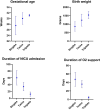Comparative analysis of risk factors for retinopathy of prematurity in single and multiple birth neonates
- PMID: 38414089
- PMCID: PMC10900704
- DOI: 10.1186/s40942-024-00536-6
Comparative analysis of risk factors for retinopathy of prematurity in single and multiple birth neonates
Abstract
Aim: To conduct a comparative analysis of risk factors for retinopathy of prematurity (ROP) in single- and multiple-born neonates.
Methods: In a retrospective evaluation of 521 premature neonates, encompassing singletons, twins, and triplets born at or before 34 weeks of gestational age with a birthweight of less than 2000 g and who completed the ROP screening program, between 2020 and 2023, in outpatient referral ROP screening clinic affiliated by Shiraz University of Medical Sciences, were included. Neonates with the eligibility criteria were enrolled in the screening program from 28 days old age and followed up to discharge or treatment based on national ROP screening guideline. Data on ROP severity, outcome, treatment modality, and risk factors, including gestational age (GA), birth weight (BW), sex, duration of neonatal intensive care unit (NICU) admission, oxygen supplementation, mechanical ventilation, blood transfusion, method of delivery, and maternal and neonatal comorbidities, were extracted and compared between premature neonates from singleton and multiple births.
Results: The analysis of the ROP severity distribution revealed 238 neonates (45.7%) with low-risk (type 2 prethreshold ROP or less severe) ROP and 16 (3.1%) with high-risk (type I prethreshold ROP or more severe) ROP who underwent treatment. According to the comparative analysis of risk factors in neonates with ROP requiring treatment, multiple birth neonates exhibited significantly greater GA (27.50 ± 3.27 vs. 30.00 ± 2.00 vs. 31.14 ± 0.38 weeks, p = 0.032 for singletons, twins and triplets, respectively); greater BW (861.67 ± 274.62 vs. 1233.33 ± 347.75 vs. 1537.14 ± 208.86 g, p = 0.002); and shorter duration of NICU admission (60.17 ± 21.36 vs. 34.00 ± 12.17 vs. 12.00 ± 6.32 days, p = 0.001) and oxygen supplementation (47.33 ± 16.57 vs. 36.00 ± 8.49 vs. 4.60 ± 2.41 days, p = 0.001). There was no significant difference between single-born neonates and multiple-born neonates regarding the prevalence of other risk factors. Multiple-born neonates with no ROP and low risk ROP showed significantly lower GA and BW compared to singletons (p < 0.001).
Conclusion: Multiple gestation neonates may develop high-risk ROP requiring treatment at a greater gestational age and birth weight and at a lower duration of oxygen supplementation and NICU admission compared to the single birth neonates. This pattern prompts a reevaluation of screening criteria, suggesting a potential need to consider multiple birth neonates with lower traditional risk factors in screening programs. This pattern should be further evaluated in larger populations of multiple born premature neonates.
Keywords: Multiple birth; Multiple gestation; ROP; Retinopathy of prematurity; Risk factor; Triplet; Twin.
© 2024. The Author(s).
Conflict of interest statement
No conflicts of interest to declare.
Figures


References
Grants and funding
LinkOut - more resources
Full Text Sources

